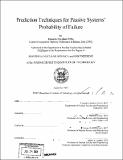| dc.contributor.advisor | Michael Golay. | en_US |
| dc.contributor.author | Cavalieri d'Oro, Edoardo | en_US |
| dc.contributor.other | Massachusetts Institute of Technology. Dept. of Nuclear Science and Engineering. | en_US |
| dc.date.accessioned | 2009-03-16T19:41:50Z | |
| dc.date.available | 2009-03-16T19:41:50Z | |
| dc.date.copyright | 2007 | en_US |
| dc.date.issued | 2007 | en_US |
| dc.identifier.uri | http://hdl.handle.net/1721.1/44778 | |
| dc.description | Thesis (S.M.)--Massachusetts Institute of Technology, Dept. of Nuclear Science and Engineering, 2007. | en_US |
| dc.description | Includes bibliographical references (p. 96-97). | en_US |
| dc.description.abstract | This work fits into the wider framework of the on-going debate centered on Passive System reliability. Its aim is to provide insights into the design of a dependable method to evaluate the reliability of Passive Systems. In order to achieve this, a method is proposed that focuses on the identification of the fundamental parameters that are critical in leading the system to failure. The selection of these parameters was done through the use of Latin Hypercube Sampling (LHS) combined with an analysis centered on the use of two statistical tools, Logistic Regression and the Classification Tree. The results yielded by this study, made it necessary to perform a systematic statistical evaluation of the efficiency of the LHS when used in the context of sensitivity analyses. The study was conducted via the visual and statistical investigation of the scatter-plots derived from the propagation of the uncertainties associated with the fundamental parameters of the plant. In order to validate the proposed method, two examples involving a Gas Fast Reactor (GFR) plant have been set up. The two examples differ, among other aspects, in the number of realizations, M, used to carry out the analyses. The first example - used to illustrate the method - is a representation of the core derived from the application of System Dynamics modeling. The second example is a RELAP5-3D model of a two-loop passive Decay Heat Removal system of the GFR. This case was designed in order to test the method in a more realistic scenario. Important findings about the applicability of the method as a function of M, are given by way of comparison between the results obtained from the two cases. The results reveal that the numbers of realizations, provided by LHS, are insufficient when used to predict and interpret the propagation of the failures in the plant. | en_US |
| dc.description.abstract | (cont.) The second important conclusion is that the resulting Probability of Failure (PF), for low values of M, does not converge to an accurate estimate. The implications of these findings are investigated trough a third study. The third example is a purely mathematical model specifically designed to test the assumptions made for the first two cases. It provides additional analysis on Examples I and II offering further support for the findings from the two. The results attained by this work suggest that further studies of this kind should be conducted in this area. | en_US |
| dc.description.statementofresponsibility | by Edoardo Cavalieri d'Oro. | en_US |
| dc.format.extent | 125 p. | en_US |
| dc.language.iso | eng | en_US |
| dc.publisher | Massachusetts Institute of Technology | en_US |
| dc.rights | M.I.T. theses are protected by
copyright. They may be viewed from this source for any purpose, but
reproduction or distribution in any format is prohibited without written
permission. See provided URL for inquiries about permission. | en_US |
| dc.rights.uri | http://dspace.mit.edu/handle/1721.1/7582 | en_US |
| dc.subject | Nuclear Science and Engineering. | en_US |
| dc.title | Prediction techniques for passive systems' probability of failure | en_US |
| dc.type | Thesis | en_US |
| dc.description.degree | S.M. | en_US |
| dc.contributor.department | Massachusetts Institute of Technology. Department of Nuclear Science and Engineering | |
| dc.identifier.oclc | 300290684 | en_US |

